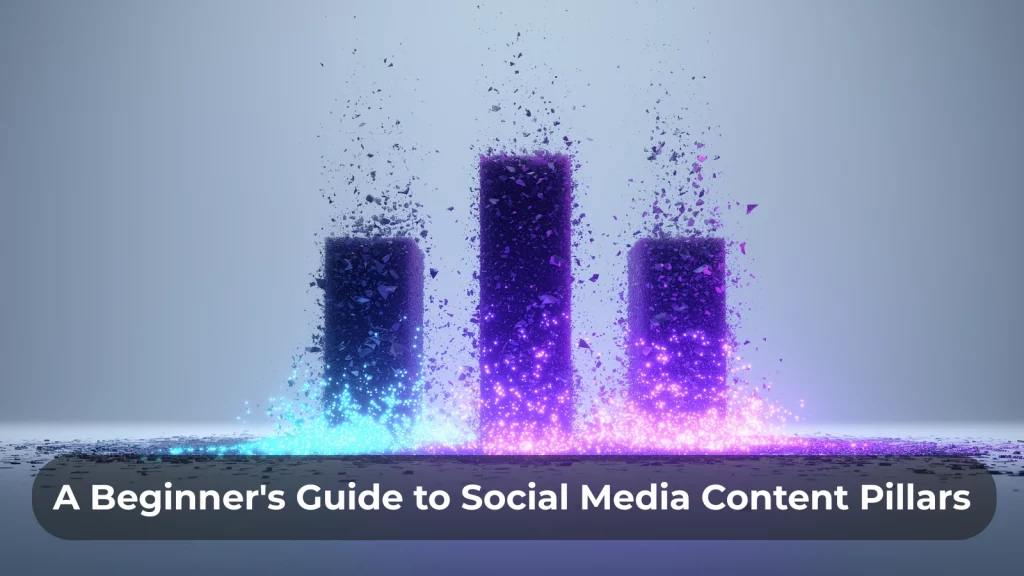Is it 4 PM on a Tuesday, and you have that familiar feeling of panic? You know you need to post on social media, but you have no idea what to say. This daily scramble for content is stressful, wastes time, and leads to “random acts of content” that get no results.
It’s a frustrating cycle. But there is a simple, strategic solution that brings order, focus, and consistency to your social media: Content Pillars.
This guide will show you exactly what they are, how they are different from SEO pillars, and how you can create your own in 5 simple steps.
The problem is that most social media metrics do not tell you what you really want to know: “Is this a good use of my time and money?”
This simple guide for UK SMEs will cut through the noise. We will show you the only three metrics you actually need to track to prove your social media is delivering a real return on investment (ROI).
What Are Social Media Content Pillars? (And How Are They Different from SEO Pillar Pages?)
This is the first and most important step, and it is where many people get confused. Let’s make it simple.
What are social media content pillars? Think of social media content pillars as 3-5 main topics or themes you will talk about regularly. They are like buckets you can use to organise your ideas. Their main purpose is to build trust and engage your audience on platforms like Facebook, Instagram, and LinkedIn.
What are brand pillars in marketing? “Brand pillars” is a wider term for the core values or ideas your entire brand is built on (e.g., “Quality,” “Innovation,” “Service”). Your social media pillars should be inspired by your brand pillars.
How are they different from SEO Pillar Pages? You have probably heard of “Pillar Pages” for your website. This is different, and the difference is simple:
- Social Media Pillars are themes for your social posts (e.g., “Team Tips”).
- SEO Pillar Pages are comprehensive web pages on your site, like our “Ultimate Guide to Social Media Strategy.“
Social pillars are your ongoing topics for engagement. SEO pillars are your big, in-depth website guides designed to rank on Google. They work together. You can use your social media pillars to test ideas for a bigger website page.


Why Your Small Business Needs a Content Pillar Strategy
A clear pillar strategy turns your social media from a time drain into a manageable task. Here is why you need one:
- It Ends the Daily Panic: Pillars eliminate the “what do I post?” headache. You will always have a list of approved topics to pull from.
- It Saves You Time: When you know your themes, you can “batch” your content. This means creating a whole week’s worth of posts in one or two hours, instead of scrambling every day.
- It Builds Trust and Consistency: Inconsistent posting (the “feast or famine” cycle) makes your brand look unreliable and hurts your performance with the algorithm. Consistency builds trust. In fact, studies show that maintaining brand consistency can increase revenue by 10-20%.
How to Choose Your Content Pillars in 5 Simple Steps
You do not need a complicated marketing degree for this. Just follow these five logical steps.
Step 1: Define Your Audience & Business Goals
You cannot choose your topics until you know who you are talking to and what you want them to do. Ask yourself: “Who is my ideal customer?” and “What is my main social media goal (e.g., get more leads)?”
Step 2: Brainstorm Your Core Topics & Themes
Get a piece of paper and write down every question your customers ask you. What are their biggest problems? What are their interests? What do you want to be known for? Just get all your ideas down on paper.
Step 3: Map Topics to Your Customer's Journey
Think about what your audience needs to know. Some people are just learning about you (Awareness), while others are ready to buy (Decision). Your pillars should have content for both. For example, a “How-To Tip” is for awareness, while a “Case Study” is for a buyer.
Step 4: Select Your 3-5 Core Pillars
Now, look at your brainstorm list and group your ideas. You will start to see patterns. How many content pillars should you have? For a small business, 3-5 is the perfect number. Any more is too complicated.
Step 5: Plan Your Content Sub-Topics
This is the final step that makes it all work. For each of your 3-5 pillars, create a list of 5-10 specific post ideas.
- Pillar: Tax Planning Tips
- Sub-Topics: 1. “What is Self Assessment?” 2. “3 ways to save on your tax bill.” 3. “Upcoming HMRC deadlines.”
Now you have a bank of ideas ready to go.
Actionable Content Pillar Examples for UK Businesses
Here are a few content pillar strategy examples to get you started:
- For a local Accounting Firm:
- Pillar 1: Tax Planning & Updates (e.g., Self Assessment reminders, HMRC rule changes)
- Pillar 2: Small Business Tips (e.g., “How to manage cash flow”)
- Pillar 3: Meet the Team (e.g., Humanising the firm)
- For a UK Recruitment Company:
- Pillar 1: Employer Insights (e.g., Hiring best practices, UK employment law)
- Pillar 2: Job Seeker Advice (e.g., CV tips, interview skills)
- Pillar 3: Hot Jobs (e.g., Promoting specific open roles)
- For a Boutique Hotel:
- Pillar 1: Food & Drink Showcase (e.g., New menu items, “Meet the Chef”)
- Pillar 2: Behind the Scenes (e.g., Prepping for a wedding, room tours)
Pillar 3: Local Area Guide (e.g., “Top 5 things to do in Manchester”)
Conclusion
Content pillars are the simple framework that turns your social media from a stressful, chaotic chore into a clear, consistent, and effective plan. They give you back your time and build a brand your customers can trust.
Download our free Content Pillar Planning Worksheet to start building your strategy today.




